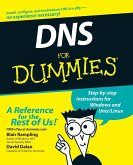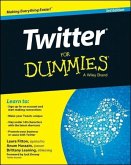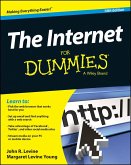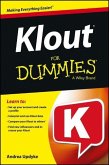Christina Tangora Schlachter
Increasing Your Influence at Work All-In-One for Dummies
Christina Tangora Schlachter
Increasing Your Influence at Work All-In-One for Dummies
- Broschiertes Buch
- Merkliste
- Auf die Merkliste
- Bewerten Bewerten
- Teilen
- Produkt teilen
- Produkterinnerung
- Produkterinnerung
Get ahead in the workplace by influencing others
Influence is a timeless topic for business leaders and others in positions of power, but the world has evolved to the point where everyone needs these skills. No matter your job, role, rank, or function, if you want to get things done you need to know how to influence up, down, across, and outside the organization.
Increasing Your Influence at Work All-in-One For Dummies shows you how to contribute more fully to important decisions, resolve conflicts more easily, lead and manage more effectively, and much more. Plus, you'll discover how to…mehr
Andere Kunden interessierten sich auch für
![Machining For Dummies Machining For Dummies]() Kip HansonMachining For Dummies29,99 €
Kip HansonMachining For Dummies29,99 €![DNS for Dummies DNS for Dummies]() Blair RamplingDNS for Dummies33,99 €
Blair RamplingDNS for Dummies33,99 €![Twitter for Dummies Twitter for Dummies]() Laura FittonTwitter for Dummies21,99 €
Laura FittonTwitter for Dummies21,99 €![Facebook All-In-One for Dummies Facebook All-In-One for Dummies]() Jamie CragerFacebook All-In-One for Dummies25,99 €
Jamie CragerFacebook All-In-One for Dummies25,99 €![The Internet For Dummies The Internet For Dummies]() John R. LevineThe Internet For Dummies25,99 €
John R. LevineThe Internet For Dummies25,99 €![Ebay.Co.UK for Dummies Ebay.Co.UK for Dummies]() Marsha CollierEbay.Co.UK for Dummies26,99 €
Marsha CollierEbay.Co.UK for Dummies26,99 €![Klout for Dummies Klout for Dummies]() Andrea UpdykeKlout for Dummies16,99 €
Andrea UpdykeKlout for Dummies16,99 €-
-
-
Get ahead in the workplace by influencing others
Influence is a timeless topic for business leaders and others in positions of power, but the world has evolved to the point where everyone needs these skills. No matter your job, role, rank, or function, if you want to get things done you need to know how to influence up, down, across, and outside the organization.
Increasing Your Influence at Work All-in-One For Dummies shows you how to contribute more fully to important decisions, resolve conflicts more easily, lead and manage more effectively, and much more. Plus, you'll discover how to develop the most important attributes necessary for influence--trustworthiness, reliability, and assertiveness--and find out how to move beyond.
_ Includes easy-to-apply information for influencing managers, peers, and subordinates
_ Shows you how to build trust with your co-workers and cultivate reliability through consistency and being personal
_ Illustrates how influencing others in the office helps you enjoy a greater measure of control over your work life
_ Helps you advance your career more rapidly than others
No matter who you are, where you work, or what your professional goals are, achieving more influence in the workplace is critical for success.
Hinweis: Dieser Artikel kann nur an eine deutsche Lieferadresse ausgeliefert werden.
Influence is a timeless topic for business leaders and others in positions of power, but the world has evolved to the point where everyone needs these skills. No matter your job, role, rank, or function, if you want to get things done you need to know how to influence up, down, across, and outside the organization.
Increasing Your Influence at Work All-in-One For Dummies shows you how to contribute more fully to important decisions, resolve conflicts more easily, lead and manage more effectively, and much more. Plus, you'll discover how to develop the most important attributes necessary for influence--trustworthiness, reliability, and assertiveness--and find out how to move beyond.
_ Includes easy-to-apply information for influencing managers, peers, and subordinates
_ Shows you how to build trust with your co-workers and cultivate reliability through consistency and being personal
_ Illustrates how influencing others in the office helps you enjoy a greater measure of control over your work life
_ Helps you advance your career more rapidly than others
No matter who you are, where you work, or what your professional goals are, achieving more influence in the workplace is critical for success.
Hinweis: Dieser Artikel kann nur an eine deutsche Lieferadresse ausgeliefert werden.
Produktdetails
- Produktdetails
- Verlag: For Dummies / Wiley & Sons
- Artikelnr. des Verlages: 1W119489060
- 1. Auflage
- Seitenzahl: 592
- Erscheinungstermin: 11. Juli 2018
- Englisch
- Abmessung: 234mm x 188mm x 33mm
- Gewicht: 771g
- ISBN-13: 9781119489061
- ISBN-10: 1119489067
- Artikelnr.: 50104179
- Herstellerkennzeichnung
- Libri GmbH
- Europaallee 1
- 36244 Bad Hersfeld
- gpsr@libri.de
- Verlag: For Dummies / Wiley & Sons
- Artikelnr. des Verlages: 1W119489060
- 1. Auflage
- Seitenzahl: 592
- Erscheinungstermin: 11. Juli 2018
- Englisch
- Abmessung: 234mm x 188mm x 33mm
- Gewicht: 771g
- ISBN-13: 9781119489061
- ISBN-10: 1119489067
- Artikelnr.: 50104179
- Herstellerkennzeichnung
- Libri GmbH
- Europaallee 1
- 36244 Bad Hersfeld
- gpsr@libri.de
Dr. Christina Tangora Schlachter, PhD, is the founder and Chief Leader of She Leads and creator of the Leading Change Guide, which helps leaders reinvent themselves and their companies with a 12-week turnaround process.
Introduction 1
About This Book 1
Foolish Assumptions 2
Icons Used in This Book 2
Beyond the Book 3
Where to Go from Here 3
Book 1: Body Talk: Influencing Through Communication and Body Language 5
Chapter 1: Building Effective Verbal Communication Techniques 7
Great Communicators Are Made, Not Born 8
Verbal Communication: When Words Matter Most 9
Cooperative Language: Verbal Communication at Its Finest 12
Chapter 2: Grasping Nonverbal Cues 21
Noting Nonverbal Techniques that Speak Volumes 21
Becoming an Expert in Active Listening 30
Chapter 3: Defining Body Language 35
Discovering How Body Language Conveys Messages 36
Examining Key Types of Gestures 41
Getting the Most Out of Body Language 47
Appreciating Cultural Differences 51
Chapter 4: Working with Different Communication Styles 53
Taking On Direct and Passive Communication Styles 54
Saying Yes to Assertiveness 58
Knowing Your Communication Style 60
Sharpening Your Communication Style 62
Chapter 5: Influencing through Communication 67
Understanding the Importance of Effective Communication 67
Communicating Quicker than the Speed of Conscious Thought 69
Understanding Why People Say Yes 70
If You Have the Need to Influence, You Get to Do All the Work 72
Navigating the Political Landscape 73
Ethically Influencing and Persuading for Results 76
It Takes Two to Influence 77
If You Aren't Getting the Desired Results, Change Your Communication 89
Chapter 6: Influencing through Body Language 93
Creating a Positive Environment 94
Pointing Your Body in the Right Direction 99
Negotiating Styles 104
Book 2: Exerting Influence Through Important Conversations 109
Chapter 1: Conversations in Good and Bad Times 111
Using Critical Conversation Tools to Develop Superstars 112
Coaching with Critical Conversations 114
Making Everyday Conversations Count 118
Opening Your Culture to Conversation 120
Preparing for a Performance Conversation 122
Having Conversations When Performance Is Suffering 122
Turning Poor Performers into Productive Performers 130
Keeping It Close to the Chest: Confidentiality Is Critical 131
Chapter 2: Hot Topics in Team Conversations 133
Creating a Productive Team 133
Improving Team Behavior 140
Chapter 3: Staff Disputes 143
Getting Results When Employees Aren't Getting Along 143
Considering Expert Tactics for Handling Staff Disputes 147
Resolving the Five Biggest Staff Disputes 153
Chapter 4: Workplace Complaints 159
Addressing Workplace Complaints 160
Using Critical Conversations When an Issue Is Raised 164
Digging into Workplace Complaints 165
Bringing in a Mediator 168
Moving Forward after Tough Workplace Conversations 171
Chapter 5: Difficult Behaviors 173
Defining Difficult Behaviors 174
Keying in on Difficult Behaviors 175
Using a Critical Conversation to Turn Around Difficult Behaviors 178
Building a Toolbox: Action Plans for Difficult Behaviors 180
Finding the Words for Special Circumstances 184
Stepping in When Bad Behavior Becomes a Pattern 188
Chapter 6: Customer Conversations 191
Helping Customer Relationships 191
Providing Exceptional Customer Service 193
Handling a Customer Who Crosses the Line 197
Delivering Bad News to Clients 199
Keeping Your Customers 201
Book 3: Peace Talks: Having Influence When You're the One Involved in
Conflict 203
Chapter 1: Identifying What Both Sides Want 205
Asking Yourself What You Really Want 206
Thinking about What the Other Person Wants 211
Taking a Look at Both Sides 214
Chapter 2: Asking for a Meeting to Talk about the Conflict 219
Considering the Best Way to Approach the Other Person 219
Preparing for Resistance 222
Setting a Time and a Place for a Productive Discussion 228
Chapter 3: Sitting Down to Talk through the Issues 231
Preparing to Mediate Your Own Conflict 232
Getting the One-on-One Started 233
Sharing Perspectives 236
Creating an Agenda 244
Looking for Win-Win Solutions 247
Concluding the Discussion 250
Chapter 4: Tailoring Your Approach to the Organizational Chart 253
Resolving Issues with Someone You Supervise 254
Addressing Conflict with a Peer 262
Having One-on-One Conversations with Your Boss 264
Book 4: Go, Team! Building Influence Across Teams and Functions 269
Chapter 1: Driving Engagement through Team Development 271
Yay, Team: Identifying Characteristics of an Engaged Team 272
Stormin' and Normin': Exploring Tuckman's Stages 274
From a Distance: Leading Teams from Afar 282
Hit Me with Your Best Shot: Conducting a High-Impact Team Workshop 283
Chapter 2: Improving Organizational Communication 285
Mind the Gap: The Great Organizational Communication Fissure 286
Establishing Two-Way Communication 287
Building a Communication Protocol 290
Maximizing the Various Communication Tools 293
Communicating Change 301
Communicating Your Engagement Efforts 304
Looking at a Few Communication Don'ts 305
Chapter 3: Strengthening Team Performance with Mindfulness 307
Identifying and Harnessing Team Dynamics 307
Improving Team Performance by Staying Focused on the Important Stuff 312
Enhancing Internal and External Business Relationships 318
Boosting Team Morale and Effort 323
Chapter 4: Using Mindfulness to Assist Different Business Functions 329
Mindfulness for Human Resources 330
Mindfulness for Occupational Health 336
Mindfulness for Learning and Organizational Development 338
Mindfulness for Customer Service 341
Mindfulness for Marketing and PR 344
Book 5: Boomers and Beyond: Influencing Across Generations 347
Chapter 1: Driving Engagement across Generations 349
Boom Baby: Working with Baby Boomers 350
X Marks the Spot: Working with Generation X 354
Working with Millennials 358
Putting It All Together 363
Chapter 2: Encouraging and Facilitating Collaboration among Generations
367
Shifting Your Perspective on Collaboration 368
Reconciling Differences: Independent Xers versus
Collaborative Millennials 370
Onboarding Millennials 376
Training Millennials 378
Mentoring Millennials and Vice Versa 379
Building a Collaborative Infrastructure 382
Chapter 3: Supercharging Your Feedback Loop 389
Giving Feedback in the Instantaneous Age 390
Rethinking the Review Session 392
Realizing that Feedback Is a Two-Way Street 403
Acting More Like a Coach Than a Boss 406
Troubleshooting Common Feedback Issues 406
Chapter 4: Motivating Millennials - Generation "Why?" 411
Managing for Meaning 412
Compensating the Noncompensation Generation 417
Rewarding Millennials 421
Chapter 5: Dropping Workplace Formalities 429
Distinguishing Between Formality at Work and Work Ethic 430
Drawing the Fine Line between Manager and Friend 442
Channeling Your Inner Emily Post: Communication
Etiquette 445
Book 6: Who's The Boss? Becoming an Influential Company Leader 451
Chapter 1: People Who Lead People: Engaging Employees through Leadership
453
Distinguishing Management versus Leadership 454
Surveying Leadership-Based Engagement Drivers 455
Understanding That Leadership Starts at the Top 456
Identifying the Behaviors and Traits of Engaged Leaders 458
Here Comes the Train Again: Training Managers to Become Engaged Leaders 462
Put Me In, Coach! Coaching for Engagement 464
Do This, Not That: Looking at Leadership Best Practices 468
Chapter 2: Establishing Trust 471
Surveying Ideas for Building Trust in Business 471
Defining Trust and Needs in the Workplace 473
Getting Others to Trust in Your Leadership 477
Setting Standards for Others by Example 479
Harnessing People Power 482
Chapter 3: Motivating the Masses 487
Peeking into the Human Motivation Theory 488
Helping People Find Their Meaning and Purpose Again 496
Practicing and Reinforcing Motivation 499
Chapter 4: Thriving on the Challenges of Leadership 505
Thriving Rather Than Surviving 506
Being a More Mindful Leader 509
Practicing Mindful Leadership 512
Coping with Stress and Pressure by Building Resilience 517
Chapter 5: Leading People, Change, and Strategy 521
Leading Mindfully When Change Is the Norm 521
Creating Strategies That Allow the Organization to Flourish 525
Creating a More Mindful Organization 533
Index 539
About This Book 1
Foolish Assumptions 2
Icons Used in This Book 2
Beyond the Book 3
Where to Go from Here 3
Book 1: Body Talk: Influencing Through Communication and Body Language 5
Chapter 1: Building Effective Verbal Communication Techniques 7
Great Communicators Are Made, Not Born 8
Verbal Communication: When Words Matter Most 9
Cooperative Language: Verbal Communication at Its Finest 12
Chapter 2: Grasping Nonverbal Cues 21
Noting Nonverbal Techniques that Speak Volumes 21
Becoming an Expert in Active Listening 30
Chapter 3: Defining Body Language 35
Discovering How Body Language Conveys Messages 36
Examining Key Types of Gestures 41
Getting the Most Out of Body Language 47
Appreciating Cultural Differences 51
Chapter 4: Working with Different Communication Styles 53
Taking On Direct and Passive Communication Styles 54
Saying Yes to Assertiveness 58
Knowing Your Communication Style 60
Sharpening Your Communication Style 62
Chapter 5: Influencing through Communication 67
Understanding the Importance of Effective Communication 67
Communicating Quicker than the Speed of Conscious Thought 69
Understanding Why People Say Yes 70
If You Have the Need to Influence, You Get to Do All the Work 72
Navigating the Political Landscape 73
Ethically Influencing and Persuading for Results 76
It Takes Two to Influence 77
If You Aren't Getting the Desired Results, Change Your Communication 89
Chapter 6: Influencing through Body Language 93
Creating a Positive Environment 94
Pointing Your Body in the Right Direction 99
Negotiating Styles 104
Book 2: Exerting Influence Through Important Conversations 109
Chapter 1: Conversations in Good and Bad Times 111
Using Critical Conversation Tools to Develop Superstars 112
Coaching with Critical Conversations 114
Making Everyday Conversations Count 118
Opening Your Culture to Conversation 120
Preparing for a Performance Conversation 122
Having Conversations When Performance Is Suffering 122
Turning Poor Performers into Productive Performers 130
Keeping It Close to the Chest: Confidentiality Is Critical 131
Chapter 2: Hot Topics in Team Conversations 133
Creating a Productive Team 133
Improving Team Behavior 140
Chapter 3: Staff Disputes 143
Getting Results When Employees Aren't Getting Along 143
Considering Expert Tactics for Handling Staff Disputes 147
Resolving the Five Biggest Staff Disputes 153
Chapter 4: Workplace Complaints 159
Addressing Workplace Complaints 160
Using Critical Conversations When an Issue Is Raised 164
Digging into Workplace Complaints 165
Bringing in a Mediator 168
Moving Forward after Tough Workplace Conversations 171
Chapter 5: Difficult Behaviors 173
Defining Difficult Behaviors 174
Keying in on Difficult Behaviors 175
Using a Critical Conversation to Turn Around Difficult Behaviors 178
Building a Toolbox: Action Plans for Difficult Behaviors 180
Finding the Words for Special Circumstances 184
Stepping in When Bad Behavior Becomes a Pattern 188
Chapter 6: Customer Conversations 191
Helping Customer Relationships 191
Providing Exceptional Customer Service 193
Handling a Customer Who Crosses the Line 197
Delivering Bad News to Clients 199
Keeping Your Customers 201
Book 3: Peace Talks: Having Influence When You're the One Involved in
Conflict 203
Chapter 1: Identifying What Both Sides Want 205
Asking Yourself What You Really Want 206
Thinking about What the Other Person Wants 211
Taking a Look at Both Sides 214
Chapter 2: Asking for a Meeting to Talk about the Conflict 219
Considering the Best Way to Approach the Other Person 219
Preparing for Resistance 222
Setting a Time and a Place for a Productive Discussion 228
Chapter 3: Sitting Down to Talk through the Issues 231
Preparing to Mediate Your Own Conflict 232
Getting the One-on-One Started 233
Sharing Perspectives 236
Creating an Agenda 244
Looking for Win-Win Solutions 247
Concluding the Discussion 250
Chapter 4: Tailoring Your Approach to the Organizational Chart 253
Resolving Issues with Someone You Supervise 254
Addressing Conflict with a Peer 262
Having One-on-One Conversations with Your Boss 264
Book 4: Go, Team! Building Influence Across Teams and Functions 269
Chapter 1: Driving Engagement through Team Development 271
Yay, Team: Identifying Characteristics of an Engaged Team 272
Stormin' and Normin': Exploring Tuckman's Stages 274
From a Distance: Leading Teams from Afar 282
Hit Me with Your Best Shot: Conducting a High-Impact Team Workshop 283
Chapter 2: Improving Organizational Communication 285
Mind the Gap: The Great Organizational Communication Fissure 286
Establishing Two-Way Communication 287
Building a Communication Protocol 290
Maximizing the Various Communication Tools 293
Communicating Change 301
Communicating Your Engagement Efforts 304
Looking at a Few Communication Don'ts 305
Chapter 3: Strengthening Team Performance with Mindfulness 307
Identifying and Harnessing Team Dynamics 307
Improving Team Performance by Staying Focused on the Important Stuff 312
Enhancing Internal and External Business Relationships 318
Boosting Team Morale and Effort 323
Chapter 4: Using Mindfulness to Assist Different Business Functions 329
Mindfulness for Human Resources 330
Mindfulness for Occupational Health 336
Mindfulness for Learning and Organizational Development 338
Mindfulness for Customer Service 341
Mindfulness for Marketing and PR 344
Book 5: Boomers and Beyond: Influencing Across Generations 347
Chapter 1: Driving Engagement across Generations 349
Boom Baby: Working with Baby Boomers 350
X Marks the Spot: Working with Generation X 354
Working with Millennials 358
Putting It All Together 363
Chapter 2: Encouraging and Facilitating Collaboration among Generations
367
Shifting Your Perspective on Collaboration 368
Reconciling Differences: Independent Xers versus
Collaborative Millennials 370
Onboarding Millennials 376
Training Millennials 378
Mentoring Millennials and Vice Versa 379
Building a Collaborative Infrastructure 382
Chapter 3: Supercharging Your Feedback Loop 389
Giving Feedback in the Instantaneous Age 390
Rethinking the Review Session 392
Realizing that Feedback Is a Two-Way Street 403
Acting More Like a Coach Than a Boss 406
Troubleshooting Common Feedback Issues 406
Chapter 4: Motivating Millennials - Generation "Why?" 411
Managing for Meaning 412
Compensating the Noncompensation Generation 417
Rewarding Millennials 421
Chapter 5: Dropping Workplace Formalities 429
Distinguishing Between Formality at Work and Work Ethic 430
Drawing the Fine Line between Manager and Friend 442
Channeling Your Inner Emily Post: Communication
Etiquette 445
Book 6: Who's The Boss? Becoming an Influential Company Leader 451
Chapter 1: People Who Lead People: Engaging Employees through Leadership
453
Distinguishing Management versus Leadership 454
Surveying Leadership-Based Engagement Drivers 455
Understanding That Leadership Starts at the Top 456
Identifying the Behaviors and Traits of Engaged Leaders 458
Here Comes the Train Again: Training Managers to Become Engaged Leaders 462
Put Me In, Coach! Coaching for Engagement 464
Do This, Not That: Looking at Leadership Best Practices 468
Chapter 2: Establishing Trust 471
Surveying Ideas for Building Trust in Business 471
Defining Trust and Needs in the Workplace 473
Getting Others to Trust in Your Leadership 477
Setting Standards for Others by Example 479
Harnessing People Power 482
Chapter 3: Motivating the Masses 487
Peeking into the Human Motivation Theory 488
Helping People Find Their Meaning and Purpose Again 496
Practicing and Reinforcing Motivation 499
Chapter 4: Thriving on the Challenges of Leadership 505
Thriving Rather Than Surviving 506
Being a More Mindful Leader 509
Practicing Mindful Leadership 512
Coping with Stress and Pressure by Building Resilience 517
Chapter 5: Leading People, Change, and Strategy 521
Leading Mindfully When Change Is the Norm 521
Creating Strategies That Allow the Organization to Flourish 525
Creating a More Mindful Organization 533
Index 539
Introduction 1
About This Book 1
Foolish Assumptions 2
Icons Used in This Book 2
Beyond the Book 3
Where to Go from Here 3
Book 1: Body Talk: Influencing Through Communication and Body Language 5
Chapter 1: Building Effective Verbal Communication Techniques 7
Great Communicators Are Made, Not Born 8
Verbal Communication: When Words Matter Most 9
Cooperative Language: Verbal Communication at Its Finest 12
Chapter 2: Grasping Nonverbal Cues 21
Noting Nonverbal Techniques that Speak Volumes 21
Becoming an Expert in Active Listening 30
Chapter 3: Defining Body Language 35
Discovering How Body Language Conveys Messages 36
Examining Key Types of Gestures 41
Getting the Most Out of Body Language 47
Appreciating Cultural Differences 51
Chapter 4: Working with Different Communication Styles 53
Taking On Direct and Passive Communication Styles 54
Saying Yes to Assertiveness 58
Knowing Your Communication Style 60
Sharpening Your Communication Style 62
Chapter 5: Influencing through Communication 67
Understanding the Importance of Effective Communication 67
Communicating Quicker than the Speed of Conscious Thought 69
Understanding Why People Say Yes 70
If You Have the Need to Influence, You Get to Do All the Work 72
Navigating the Political Landscape 73
Ethically Influencing and Persuading for Results 76
It Takes Two to Influence 77
If You Aren't Getting the Desired Results, Change Your Communication 89
Chapter 6: Influencing through Body Language 93
Creating a Positive Environment 94
Pointing Your Body in the Right Direction 99
Negotiating Styles 104
Book 2: Exerting Influence Through Important Conversations 109
Chapter 1: Conversations in Good and Bad Times 111
Using Critical Conversation Tools to Develop Superstars 112
Coaching with Critical Conversations 114
Making Everyday Conversations Count 118
Opening Your Culture to Conversation 120
Preparing for a Performance Conversation 122
Having Conversations When Performance Is Suffering 122
Turning Poor Performers into Productive Performers 130
Keeping It Close to the Chest: Confidentiality Is Critical 131
Chapter 2: Hot Topics in Team Conversations 133
Creating a Productive Team 133
Improving Team Behavior 140
Chapter 3: Staff Disputes 143
Getting Results When Employees Aren't Getting Along 143
Considering Expert Tactics for Handling Staff Disputes 147
Resolving the Five Biggest Staff Disputes 153
Chapter 4: Workplace Complaints 159
Addressing Workplace Complaints 160
Using Critical Conversations When an Issue Is Raised 164
Digging into Workplace Complaints 165
Bringing in a Mediator 168
Moving Forward after Tough Workplace Conversations 171
Chapter 5: Difficult Behaviors 173
Defining Difficult Behaviors 174
Keying in on Difficult Behaviors 175
Using a Critical Conversation to Turn Around Difficult Behaviors 178
Building a Toolbox: Action Plans for Difficult Behaviors 180
Finding the Words for Special Circumstances 184
Stepping in When Bad Behavior Becomes a Pattern 188
Chapter 6: Customer Conversations 191
Helping Customer Relationships 191
Providing Exceptional Customer Service 193
Handling a Customer Who Crosses the Line 197
Delivering Bad News to Clients 199
Keeping Your Customers 201
Book 3: Peace Talks: Having Influence When You're the One Involved in
Conflict 203
Chapter 1: Identifying What Both Sides Want 205
Asking Yourself What You Really Want 206
Thinking about What the Other Person Wants 211
Taking a Look at Both Sides 214
Chapter 2: Asking for a Meeting to Talk about the Conflict 219
Considering the Best Way to Approach the Other Person 219
Preparing for Resistance 222
Setting a Time and a Place for a Productive Discussion 228
Chapter 3: Sitting Down to Talk through the Issues 231
Preparing to Mediate Your Own Conflict 232
Getting the One-on-One Started 233
Sharing Perspectives 236
Creating an Agenda 244
Looking for Win-Win Solutions 247
Concluding the Discussion 250
Chapter 4: Tailoring Your Approach to the Organizational Chart 253
Resolving Issues with Someone You Supervise 254
Addressing Conflict with a Peer 262
Having One-on-One Conversations with Your Boss 264
Book 4: Go, Team! Building Influence Across Teams and Functions 269
Chapter 1: Driving Engagement through Team Development 271
Yay, Team: Identifying Characteristics of an Engaged Team 272
Stormin' and Normin': Exploring Tuckman's Stages 274
From a Distance: Leading Teams from Afar 282
Hit Me with Your Best Shot: Conducting a High-Impact Team Workshop 283
Chapter 2: Improving Organizational Communication 285
Mind the Gap: The Great Organizational Communication Fissure 286
Establishing Two-Way Communication 287
Building a Communication Protocol 290
Maximizing the Various Communication Tools 293
Communicating Change 301
Communicating Your Engagement Efforts 304
Looking at a Few Communication Don'ts 305
Chapter 3: Strengthening Team Performance with Mindfulness 307
Identifying and Harnessing Team Dynamics 307
Improving Team Performance by Staying Focused on the Important Stuff 312
Enhancing Internal and External Business Relationships 318
Boosting Team Morale and Effort 323
Chapter 4: Using Mindfulness to Assist Different Business Functions 329
Mindfulness for Human Resources 330
Mindfulness for Occupational Health 336
Mindfulness for Learning and Organizational Development 338
Mindfulness for Customer Service 341
Mindfulness for Marketing and PR 344
Book 5: Boomers and Beyond: Influencing Across Generations 347
Chapter 1: Driving Engagement across Generations 349
Boom Baby: Working with Baby Boomers 350
X Marks the Spot: Working with Generation X 354
Working with Millennials 358
Putting It All Together 363
Chapter 2: Encouraging and Facilitating Collaboration among Generations
367
Shifting Your Perspective on Collaboration 368
Reconciling Differences: Independent Xers versus
Collaborative Millennials 370
Onboarding Millennials 376
Training Millennials 378
Mentoring Millennials and Vice Versa 379
Building a Collaborative Infrastructure 382
Chapter 3: Supercharging Your Feedback Loop 389
Giving Feedback in the Instantaneous Age 390
Rethinking the Review Session 392
Realizing that Feedback Is a Two-Way Street 403
Acting More Like a Coach Than a Boss 406
Troubleshooting Common Feedback Issues 406
Chapter 4: Motivating Millennials - Generation "Why?" 411
Managing for Meaning 412
Compensating the Noncompensation Generation 417
Rewarding Millennials 421
Chapter 5: Dropping Workplace Formalities 429
Distinguishing Between Formality at Work and Work Ethic 430
Drawing the Fine Line between Manager and Friend 442
Channeling Your Inner Emily Post: Communication
Etiquette 445
Book 6: Who's The Boss? Becoming an Influential Company Leader 451
Chapter 1: People Who Lead People: Engaging Employees through Leadership
453
Distinguishing Management versus Leadership 454
Surveying Leadership-Based Engagement Drivers 455
Understanding That Leadership Starts at the Top 456
Identifying the Behaviors and Traits of Engaged Leaders 458
Here Comes the Train Again: Training Managers to Become Engaged Leaders 462
Put Me In, Coach! Coaching for Engagement 464
Do This, Not That: Looking at Leadership Best Practices 468
Chapter 2: Establishing Trust 471
Surveying Ideas for Building Trust in Business 471
Defining Trust and Needs in the Workplace 473
Getting Others to Trust in Your Leadership 477
Setting Standards for Others by Example 479
Harnessing People Power 482
Chapter 3: Motivating the Masses 487
Peeking into the Human Motivation Theory 488
Helping People Find Their Meaning and Purpose Again 496
Practicing and Reinforcing Motivation 499
Chapter 4: Thriving on the Challenges of Leadership 505
Thriving Rather Than Surviving 506
Being a More Mindful Leader 509
Practicing Mindful Leadership 512
Coping with Stress and Pressure by Building Resilience 517
Chapter 5: Leading People, Change, and Strategy 521
Leading Mindfully When Change Is the Norm 521
Creating Strategies That Allow the Organization to Flourish 525
Creating a More Mindful Organization 533
Index 539
About This Book 1
Foolish Assumptions 2
Icons Used in This Book 2
Beyond the Book 3
Where to Go from Here 3
Book 1: Body Talk: Influencing Through Communication and Body Language 5
Chapter 1: Building Effective Verbal Communication Techniques 7
Great Communicators Are Made, Not Born 8
Verbal Communication: When Words Matter Most 9
Cooperative Language: Verbal Communication at Its Finest 12
Chapter 2: Grasping Nonverbal Cues 21
Noting Nonverbal Techniques that Speak Volumes 21
Becoming an Expert in Active Listening 30
Chapter 3: Defining Body Language 35
Discovering How Body Language Conveys Messages 36
Examining Key Types of Gestures 41
Getting the Most Out of Body Language 47
Appreciating Cultural Differences 51
Chapter 4: Working with Different Communication Styles 53
Taking On Direct and Passive Communication Styles 54
Saying Yes to Assertiveness 58
Knowing Your Communication Style 60
Sharpening Your Communication Style 62
Chapter 5: Influencing through Communication 67
Understanding the Importance of Effective Communication 67
Communicating Quicker than the Speed of Conscious Thought 69
Understanding Why People Say Yes 70
If You Have the Need to Influence, You Get to Do All the Work 72
Navigating the Political Landscape 73
Ethically Influencing and Persuading for Results 76
It Takes Two to Influence 77
If You Aren't Getting the Desired Results, Change Your Communication 89
Chapter 6: Influencing through Body Language 93
Creating a Positive Environment 94
Pointing Your Body in the Right Direction 99
Negotiating Styles 104
Book 2: Exerting Influence Through Important Conversations 109
Chapter 1: Conversations in Good and Bad Times 111
Using Critical Conversation Tools to Develop Superstars 112
Coaching with Critical Conversations 114
Making Everyday Conversations Count 118
Opening Your Culture to Conversation 120
Preparing for a Performance Conversation 122
Having Conversations When Performance Is Suffering 122
Turning Poor Performers into Productive Performers 130
Keeping It Close to the Chest: Confidentiality Is Critical 131
Chapter 2: Hot Topics in Team Conversations 133
Creating a Productive Team 133
Improving Team Behavior 140
Chapter 3: Staff Disputes 143
Getting Results When Employees Aren't Getting Along 143
Considering Expert Tactics for Handling Staff Disputes 147
Resolving the Five Biggest Staff Disputes 153
Chapter 4: Workplace Complaints 159
Addressing Workplace Complaints 160
Using Critical Conversations When an Issue Is Raised 164
Digging into Workplace Complaints 165
Bringing in a Mediator 168
Moving Forward after Tough Workplace Conversations 171
Chapter 5: Difficult Behaviors 173
Defining Difficult Behaviors 174
Keying in on Difficult Behaviors 175
Using a Critical Conversation to Turn Around Difficult Behaviors 178
Building a Toolbox: Action Plans for Difficult Behaviors 180
Finding the Words for Special Circumstances 184
Stepping in When Bad Behavior Becomes a Pattern 188
Chapter 6: Customer Conversations 191
Helping Customer Relationships 191
Providing Exceptional Customer Service 193
Handling a Customer Who Crosses the Line 197
Delivering Bad News to Clients 199
Keeping Your Customers 201
Book 3: Peace Talks: Having Influence When You're the One Involved in
Conflict 203
Chapter 1: Identifying What Both Sides Want 205
Asking Yourself What You Really Want 206
Thinking about What the Other Person Wants 211
Taking a Look at Both Sides 214
Chapter 2: Asking for a Meeting to Talk about the Conflict 219
Considering the Best Way to Approach the Other Person 219
Preparing for Resistance 222
Setting a Time and a Place for a Productive Discussion 228
Chapter 3: Sitting Down to Talk through the Issues 231
Preparing to Mediate Your Own Conflict 232
Getting the One-on-One Started 233
Sharing Perspectives 236
Creating an Agenda 244
Looking for Win-Win Solutions 247
Concluding the Discussion 250
Chapter 4: Tailoring Your Approach to the Organizational Chart 253
Resolving Issues with Someone You Supervise 254
Addressing Conflict with a Peer 262
Having One-on-One Conversations with Your Boss 264
Book 4: Go, Team! Building Influence Across Teams and Functions 269
Chapter 1: Driving Engagement through Team Development 271
Yay, Team: Identifying Characteristics of an Engaged Team 272
Stormin' and Normin': Exploring Tuckman's Stages 274
From a Distance: Leading Teams from Afar 282
Hit Me with Your Best Shot: Conducting a High-Impact Team Workshop 283
Chapter 2: Improving Organizational Communication 285
Mind the Gap: The Great Organizational Communication Fissure 286
Establishing Two-Way Communication 287
Building a Communication Protocol 290
Maximizing the Various Communication Tools 293
Communicating Change 301
Communicating Your Engagement Efforts 304
Looking at a Few Communication Don'ts 305
Chapter 3: Strengthening Team Performance with Mindfulness 307
Identifying and Harnessing Team Dynamics 307
Improving Team Performance by Staying Focused on the Important Stuff 312
Enhancing Internal and External Business Relationships 318
Boosting Team Morale and Effort 323
Chapter 4: Using Mindfulness to Assist Different Business Functions 329
Mindfulness for Human Resources 330
Mindfulness for Occupational Health 336
Mindfulness for Learning and Organizational Development 338
Mindfulness for Customer Service 341
Mindfulness for Marketing and PR 344
Book 5: Boomers and Beyond: Influencing Across Generations 347
Chapter 1: Driving Engagement across Generations 349
Boom Baby: Working with Baby Boomers 350
X Marks the Spot: Working with Generation X 354
Working with Millennials 358
Putting It All Together 363
Chapter 2: Encouraging and Facilitating Collaboration among Generations
367
Shifting Your Perspective on Collaboration 368
Reconciling Differences: Independent Xers versus
Collaborative Millennials 370
Onboarding Millennials 376
Training Millennials 378
Mentoring Millennials and Vice Versa 379
Building a Collaborative Infrastructure 382
Chapter 3: Supercharging Your Feedback Loop 389
Giving Feedback in the Instantaneous Age 390
Rethinking the Review Session 392
Realizing that Feedback Is a Two-Way Street 403
Acting More Like a Coach Than a Boss 406
Troubleshooting Common Feedback Issues 406
Chapter 4: Motivating Millennials - Generation "Why?" 411
Managing for Meaning 412
Compensating the Noncompensation Generation 417
Rewarding Millennials 421
Chapter 5: Dropping Workplace Formalities 429
Distinguishing Between Formality at Work and Work Ethic 430
Drawing the Fine Line between Manager and Friend 442
Channeling Your Inner Emily Post: Communication
Etiquette 445
Book 6: Who's The Boss? Becoming an Influential Company Leader 451
Chapter 1: People Who Lead People: Engaging Employees through Leadership
453
Distinguishing Management versus Leadership 454
Surveying Leadership-Based Engagement Drivers 455
Understanding That Leadership Starts at the Top 456
Identifying the Behaviors and Traits of Engaged Leaders 458
Here Comes the Train Again: Training Managers to Become Engaged Leaders 462
Put Me In, Coach! Coaching for Engagement 464
Do This, Not That: Looking at Leadership Best Practices 468
Chapter 2: Establishing Trust 471
Surveying Ideas for Building Trust in Business 471
Defining Trust and Needs in the Workplace 473
Getting Others to Trust in Your Leadership 477
Setting Standards for Others by Example 479
Harnessing People Power 482
Chapter 3: Motivating the Masses 487
Peeking into the Human Motivation Theory 488
Helping People Find Their Meaning and Purpose Again 496
Practicing and Reinforcing Motivation 499
Chapter 4: Thriving on the Challenges of Leadership 505
Thriving Rather Than Surviving 506
Being a More Mindful Leader 509
Practicing Mindful Leadership 512
Coping with Stress and Pressure by Building Resilience 517
Chapter 5: Leading People, Change, and Strategy 521
Leading Mindfully When Change Is the Norm 521
Creating Strategies That Allow the Organization to Flourish 525
Creating a More Mindful Organization 533
Index 539








